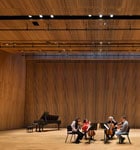The existing concrete building needed to be completely redesigned. It had to be insulated from outside vibrations as well as other practice rooms that might contain pianists, orchestras, or dancers. The acoustics needed to be finely tuned to mimic a concert hall, and the elements used for these intricate engineering challenges needed to be sustainably sourced. This was the challenge H3 Hardy Collaboration Architecture encountered as it undertook the Orchestra of St. Luke’s DiMenna Center for Classical Music. H3’s final design is as beautiful as it is functional and earned LEED Gold certification. Below, gb&d presents an anatomy of the building and its most striking and sustainable elements.
A. An inviting entrance. The existing envelope of this structure was mostly concrete with very few windows, making the lobby dim and dysfunctional. The wind off the nearby Hudson River was so strong that guests often couldn’t open the door. So, H3 created an original design of channel glass so that passersby could see inside the lobby, and the firm replaced the original doors with revolving ones to make them easier to use. At one end of the lobby, H3 used a high-gloss red paint on the wall to create an inviting glow. Hugh Hardy, the firm’s principal and founder, says this abstract minimalism works well to liven up the space.

A. The DiMenna Center is housed in the lower half of an existing concrete building originally designed as an Off Broadway theater. H3 Hardy used channel glass to create a more inviting lobby.
B. Acoustical environments. The DiMenna Center is a rehearsal space, so H3 had to provide acoustics that would mimic a concert hall—not an empty room. The acoustical shapings of Cary Hall—sculptured bumps and slopes—are actually hidden behind the FSC-certified wooden slats, which are set in a repeating pattern that is purely aesthetic. H3 worked with George Sexton Associates to create a combination of natural skylights—which are covered with a milky film so that direct light never interferes with rehearsals—and metal-halide lights that are both energy-efficient and acoustically beneficial. To account for vibrations, the practice hall is “essentially floating,” Hardy says. “Everything sits on pads and springs so that vibrations from surrounding rooms can’t be heard.”

B. Acoustics in Cary Hall.
C. A mixture of lighting. In both Cary Hall and Benzaquen Hall, H3 again mixed natural and artificial lighting. Normally, concert halls use halogen lights, which are beautiful and warm but can be very hot and extraordinarily energy intensive. Hardy created two layers of windows and skylights that admit but diffuse the natural light. “We saved a huge amount of energy with beautiful lighting,” Hardy says. “We will have saved the owner tens of thousands of dollars a year.”

C. The DiMenna Center’s green features are hardly obvious. Highly efficient mechanical and lighting systems save the building owner tens of thousands of dollars per year, and H3 adaptively reused as much of the concrete structure as possible, including this existing staircase.
D. Behind-the-walls engineering. Structural limitations of the building presented some of the biggest challenges that Hardy and his team faced. The space was formerly an Off Broadway theater with a balcony, and H3 needed to transform it into usable, isolated rehearsal studios. To properly engineer the springs and pads that float Cary Hall, H3 had to place structurally heavy loads in the basement below the room, “the only place we could go,” Hardy says. The back of the building is “a giant cantilever,” he adds. “We had to cut a lot of holes.” Hardy managed to do much of this sustainably as well, focusing much of the green efforts behind the walls. “On a project like this,” he says, “there’s so much behind the walls and in the ceiling that you really only see a small part of what goes into the building.”

D. A rendered section looking east shows the stacking of the two large rehearsal rooms and the placement of the smaller practice spaces. The layout was dictated largely by the existing building.

